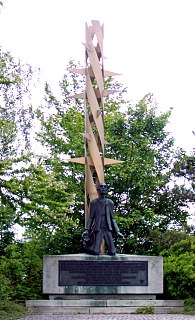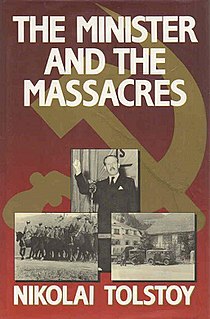
The Yalta Conference, also known as the Crimea Conference and code-named Argonaut, held February 4–11, 1945, was the World War II meeting of the heads of government of the United States, the United Kingdom, and the Soviet Union to discuss the postwar reorganization of Germany and Europe. The three states were represented by President Franklin D. Roosevelt, Prime Minister Winston Churchill, and Premier Joseph Stalin, respectively. The conference was held near Yalta in Crimea, Soviet Union, within the Livadia, Yusupov, and Vorontsov Palaces.
Operation Keelhaul was a forced repatriation of former Soviet Armed Forces POWs of Germany to the Soviet Union, carried out in Northern Italy by British and American forces between 14 August 1946 and 9 May 1947. Anti-communist Yugoslavs and Hungarians were also forcibly repatriated to their respective governments.

The final battles of the European Theatre of World War II, as well as the overall surrender of Nazi Germany to the Allies, took place in late April and early May 1945.

Count Nikolai Dmitrievich Tolstoy-Miloslavsky is a Russo-British monarchist and historian who writes under the name Nikolai Tolstoy. He is a former parliamentary candidate of the UK Independence Party and is the current nominal head of the House of Tolstoy, a Russian noble family.

Disarmed Enemy Forces was a US designation for soldiers who surrendered to an adversary after hostilities ended, and for those POWs who had already surrendered and were held in camps in occupied German territory at the time. It was General Dwight D. Eisenhower's designation of German prisoners in post-World War II occupied Germany.
The Bleiburg repatriations occurred in May 1945, at the end of World War II in Europe. Tens of thousands of soldiers and civilians associated with the Axis powers fled Yugoslavia to Austria as the Soviet Union and Yugoslav Partisans took control. When they reached Austria, the British refused to accept their surrender and directed them to the Partisans instead. The prisoners of war were subjected to forced marches, together with columns captured by other Partisans in Yugoslavia. Tens of thousands were executed; others were taken to forced labor camps, where more died from harsh conditions. The events are named for the Carinthian border town of Bleiburg, where the initial repatriation was carried out.

Helmuth von Pannwitz was a German general who was a cavalry officer during the First and the Second World Wars. Later he became a Lieutenant General of the Wehrmacht, a SS-Obergruppenführer of the Waffen-SS, and Feldataman of the XV SS Cossack Cavalry Corps. In 1947 he was tried for war crimes under Ukase 43 by the Military Collegium of the Supreme Court of the Soviet Union, sentenced to death on 16 January 1947 and executed in Lefortovo Prison the same day. He was rehabilitated by a military prosecutor in Moscow in April 1996. In June 2001, however, the reversal of the conviction of Pannwitz was overturned and his conviction was reinstated.

Forced labor of Germans in the Soviet Union was considered by the Soviet Union to be part of German war reparations for the damage inflicted by Nazi Germany on the Soviet Union during the Axis-Soviet campaigns (1941-1945) of World War II. Soviet authorities deported German civilians from Germany and Eastern Europe to the USSR after World War II as forced laborers, while ethnic Germans living in the USSR were deported during World War II and conscripted for forced labor. German prisoners of war were also used as a source of forced labor during and after the war by the Soviet Union and by the Western Allies.
The Repatriation of Cossacks occurred when Cossacks, ethnic Russians and Ukrainians who were against the Soviet Union, were handed over by British and American forces to the Soviet Union after the Second World War. The repatriations were agreed to in the Yalta Conference; Joseph Stalin claimed the repatriated people were Soviet citizens as of 1939, although many of them had left Russia before or soon after the end of the Russian Civil War or had been born abroad.

General Sir Charles Frederic Keightley, was a British Army officer during and following the Second World War. After serving with distinction during the Second World War – becoming the army's youngest corps commander – he had a distinguished postwar career and was the Governor of Gibraltar from 1958 to 1962.

Ostarbeiter was a Nazi German designation for foreign slave workers gathered from occupied Central and Eastern Europe to perform forced labor in Germany during World War II. The Germans started deporting civilians at the beginning of the war and began doing so at unprecedented levels following Operation Barbarossa in 1941. They apprehended Ostarbeiter from the newly-formed German districts of Reichskommissariat Ukraine, District of Galicia, and Reichskommissariat Ostland. These areas comprised German-occupied Poland and the conquered territories of the Soviet Union. According to Pavel Polian, over 50% of Ostarbeiters were formerly Soviet subjects originating from the territory of modern-day Ukraine, followed by Polish women workers. Eastern workers included ethnic Ukrainians, Poles, Belarusians, Russians, Tatars, and others. Estimates of the number of Ostarbeiter range between 3 million and 5.5 million.

The 162nd Turkistan Division was a military division that was formed by the German Army during the Second World War. It drew its men from prisoners of war who came from the Caucasus and from Turkic lands further east.

Approximately three million German prisoners of war were captured by the Soviet Union during World War II, most of them during the great advances of the Red Army in the last year of the war. The POWs were employed as forced labor in the Soviet wartime economy and post-war reconstruction. By 1950 almost all surviving POWs had been released, with the last prisoner returning from the USSR in 1956. According to Soviet records 381,067 German Wehrmacht POWs died in NKVD camps.

In the years following World War II, large numbers of German civilians and captured soldiers were forced into labor by the Allied forces. The topic of using Germans as forced labor for reparations was first broached at the Tehran conference in 1943, where Soviet premier Joseph Stalin demanded 4,000,000 German workers.

The Minister and the Massacres (1986) is a history written by Nikolai Tolstoy about the 1945 repatriations of Croatian soldiers and civilians and Cossacks, who had crossed into Austria seeking refuge from the Red Army and Partisans who had taken control in Yugoslavia. He criticized the British repatriation of collaborationist troops to Josip Broz Tito's Yugoslav government, attributing the decisions to Harold Macmillan, then UK minister of the Mediterranean, and Lord Aldington. Tolstoy is among historians who say numerous massacres of such soldiers took place after their repatriation. His conclusions about leading British officials were criticized in turn.
Some Soviet prisoners of war who survived German captivity during World War II were accused by the Soviet authorities of collaboration with the Nazis or branded as traitors under Order No. 270, which prohibited any soldier from surrendering.
NKVD screening and filtration camps, originally known as NKVD special-purpose camps / NKVD special camps, were camps for the screening of the Soviet soldiers returned from enemy imprisonment or encirclement. By the end of World War II they handled screening of all people from the Soviet territories occupied by Nazi Germany. The NKVD special-purpose camps were established by NKVD Order No. 001735 of December 28, 1941, titled "О создании специальных лагерей для бывших военнослужащих Красной Армии, находившихся в плену и в окружении противника". By NKVD Order No. 00100 of February 20, 1945, they were renamed to "проверочно-фильтрационные лагеря". Surviving POWs, about 1.5 million, repatriated Ostarbeiter, and other displaced persons, totally more than 4,000,000 people were sent to special NKVD filtration camps. By 1946, 80% civilians and 20% of PoWs were freed, 5% of civilians, and 43% of PoWs re-drafted, 10% of civilians and 22% of PoWs were sent to labor battalions, and 2% of civilians and 15% of the PoWs transferred to the NKVD, i.e. the Gulag.

Twelve Responses to Tragedy, or the Yalta Memorial, is a memorial located in the Yalta Memorial Garden on Cromwell Road in South Kensington in west London. The memorial commemorates people displaced as a result of the Yalta Conference at the conclusion of the Second World War. Created by the British sculptor Angela Conner, the work consists of twelve bronze busts atop a stone base. The memorial was dedicated in 1986 to replace a previous memorial from 1982 that had been repeatedly damaged by vandalism.
Anthony Wilson Cowgill was a British soldier, engineer and researcher. After a 30-year career in the Army he worked for Rolls-Royce and set up a company offering information and access to government. Past retirement age he initiated his own private inquiry into the Repatriation of Cossacks after World War II, and published the English texts of European Union treaties.
Vyacheslav Grigorievich Naumenko was a Kuban Cossack leader and historian.












